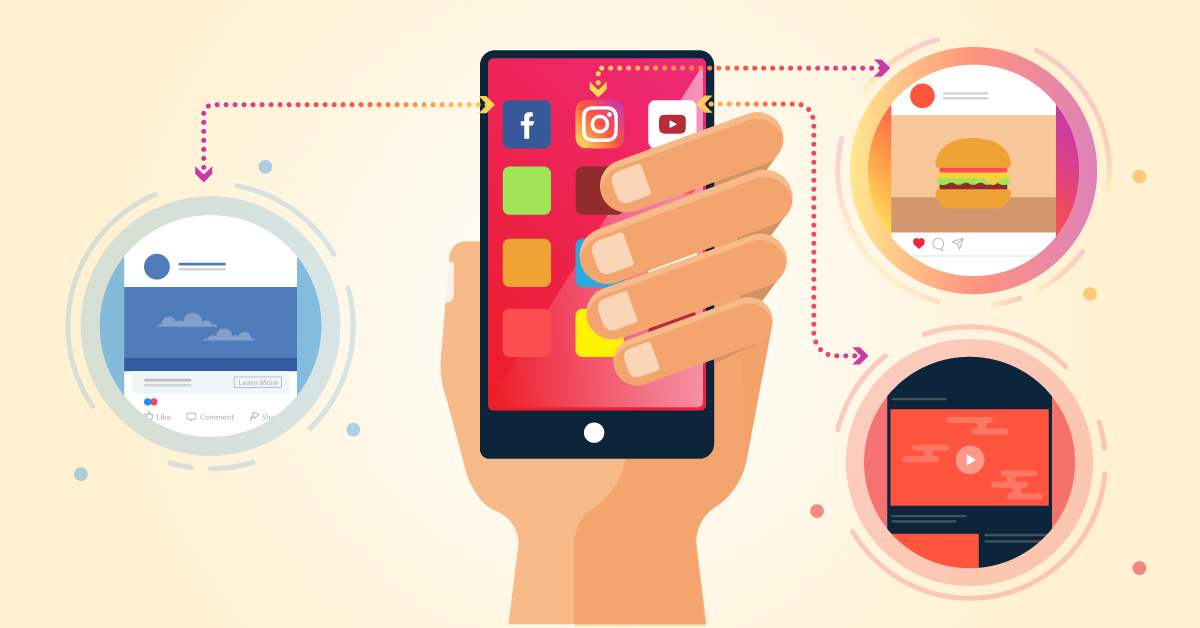The evolution of social media has been fueled by the human impulse to communicate and by advances in digital technology. It is a story about establishing and nurturing personal connections at scale.
According to Merriam-Webster, social media is defined as “forms of electronic communication (such as websites for social networking and microblogging) through which users create online communities to share information, ideas, personal messages, and other content (such as videos).” The 2019 Pew Research Center report on social media use in the United States showed that 72% of American adults use some form of social media. In 2005, the year after Facebook went live, that number was 5%.
What follows is an examination of the origins of social media, its relatively rapid growth as a sociological and commercial force, and the change it has brought to the marketing world.

Contents
A Brief History of Social Media
In less than a generation, social media has evolved from direct electronic information exchange, to virtual gathering place, to retail platform, to vital 21st-century marketing tool.
How did it begin? How has social media affected the lives of billions of people? How have businesses adapted to the digital consumer lifestyle? How do marketing professionals use social media? It’s all part of the story of social media’s ongoing evolution.
Pre-internet Roots
In a sense, social media began on May 24, 1844, with a series of electronic dots and dashes tapped out by hand on a telegraph machine.
The first electronic message from Baltimore to Washington, D.C., proved Samuel Morse understood the historic ramifications of his scientific achievement: “What hath God wrought?” he wrote.
A recent article in The Washington Post, “Before Twitter and Facebook, There Was Morse Code: Remembering Social Media’s True Inventor,” details the history and relevance of Morse code, complete with early versions of today’s “OMG” and “LOL.”
While the roots of digital communication run deep, most contemporary accounts of the modern origins of today’s internet and social media point to the emergence in 1969 of the Advanced Research Projects Agency Network — the ARPANET.
This early digital network, created by the United States Department of Defense, allowed scientists at four interconnected universities to share software, hardware, and other data.
In 1987, the direct precursor to today’s internet came into being when the National Science Foundation launched a more robust, nationwide digital network known as the NSFNET. A decade later, in 1997, the first true social media platform was launched.
The Launch of Social Sites
In the 1980s and ’90s, according to “The History of Social Networking” on the technology news site Digital Trends, the internet’s growth enabled the introduction of online communication services such as CompuServe, America Online, and Prodigy. They introduced users to digital communication through email, bulletin board messaging, and real-time online chatting.
This gave rise to the earliest social media networks, beginning with the short-lived Six Degrees profile uploading service in 1997.
This service was followed in 2001 by Friendster. These rudimentary platforms attracted millions of users and enabled email address registration and basic online networking.
Weblogs, or blogs, another early form of digital social communication, began to gain popularity with the 1999 launch of the LiveJournal publishing site. This coincided with the launch of the Blogger publishing platform by the tech company Pyra Labs, which was purchased by Google in 2003.
In 2002, LinkedIn was founded as a networking site for career-minded professionals. By 2020, it had grown to more than 675 million users worldwide. It remains the social media site of choice for job seekers as well as human resources managers searching for qualified candidates.
Two other major forays into social media collapsed after a burst of initial success. In 2003, Myspace launched. By 2006, it was the most visited website on the planet, spurred by users’ ability to share new music directly on their profile pages.
By 2008, it was eclipsed by Facebook. In 2011, Myspace was purchased by musician Justin Timberlake for $35 million, but it has since become a social media afterthought.
Google’s attempt to elbow its way into the social media landscape, Google+, launched in 2012. A rocky existence came to an end in 2018, after the private information of nearly 500,000 Google+ users was compromised by a data security breach.
Back To Top

Modern Social Media Outlets
Today’s social media landscape is populated by a suite of services that jockey for the attention of more than 5 billion mobile device users worldwide. Here is an overview of the most prominent social media networks of 2020:
Launched in 2004 by Harvard student Mark Zuckerberg, it has nearly 1.7 billion users — including 69% of U.S. adults, according to Pew Research.
- HubSpot: Facebook Marketing
Launched in 2005 by Massachusetts 20-somethings Steve Huffman and Alexis Ohanian as a news-sharing platform, its 300 million users have transformed Reddit into a combination news aggregation/social commentary site. Its popularity is based on the ability to “up-vote” and “down-vote” user posts.
- Social Media Examiner: How to Market on Reddit: A Guide for Businesses
Founded in 2006 by Jack Dorsey, Evan Williams, Biz Stone, and others as a microblogging site, by 2020, 22% of U.S. adults were Twitter users, according to Pew Research.
- Hootsuite: Twitter Marketing: The Complete Guide for Business
Founded in 2010 by Stanford graduate Kevin Systrom as a photo-sharing site and purchased by Facebook in 2012, Instagram has more than 1 billion users worldwide.
- HubSpot: Instagram Marketing: The Ultimate Guide
Founded in 2010 by iPhone app developer Ben Silbermann as a visual “pin board,” Pinterest became a publicly traded company in 2019 and has more than 335 million active monthly users.
- Sprout Social: Your 5-Step Pinterest Marketing Guide
Snapchat
Founded in 2011 by a trio of Stanford students — Evan Spiegel, Reggie Brown, and Bobby Murphy — this video-sharing service introduced the concept of “stories,” or serialized short videos, and “filters,” run for informative digital effects, often based on location.
- Hootsuite: Snapchat for Business
TikTok
Founded in 2016 by Chinese tech company ByteDance, this short-form video-sharing site was merged with the U.S.-based mobile app Musical.ly in 2018 and became popular with American teens and young adults. As of early 2020, it had more than 800 million users worldwide.
- Business Insider: TikTok Marketing Trends & Predictions for 2020
Back To Top
Social Media: End Users and Businesses
What began as a desktop or laptop experience shifted to mobile phones and tablets as cellular service expanded; the capabilities of cellular phones expanded, turning them into “smartphones”; and high-speed wireless internet became more readily available in homes, businesses, and public spaces.
With the advent of social media apps that could run on smartphones, end users could take their communities with them wherever they went.
Businesses took advantage of this new consumer mobility by serving their customers new, simpler methods of interacting — and new ways of buying goods and services.
The End-User Experience
At first, social media existed to help end users connect digitally with friends, colleagues, family members, and like-minded individuals they might never have met in person. Desktop access to bulletin board services such as CompuServe and Prodigy made it easier to grow free online communities without ever leaving the house.
The invention of the smartphone liberated social media from the desktop and laptop computer. Apple’s first iPhone, launched by Steve Jobs in 2007, helped shift the focus of online community building to mobile. Facebook, Twitter, Snapchat, Instagram, TikTok, and other social media services thrived in the mobile app environment.
Technological improvements — specifically, powerful in-phone cameras — shifted the focus of mobile apps to video and images. In addition to written messages, end users could now broadcast in real time.
Instagram, in particular, became the app of choice for social media users interested in travel, entertainment, fashion, and other visually oriented topics.
The Business Experience
As social media companies grew their user bases into the hundreds of millions, the business applications of Facebook, Twitter, and other social platforms began to take shape. Social media companies had access to some of the richest trackable user data ever conceived.
A recent article on IAS Insider, “The Evolution of Social Media Advertising,” sums it up: “Users don’t just log in and browse, they tell the platforms their name, and where they live, what they like and who they know, painting the most vivid picture currently possible for marketers looking to target specific consumers.”
Facebook began to place ads on its platform as early as 2006. Twitter enabled ads in 2010. LinkedIn, Instagram, Pinterest, Snapchat, and TikTok all have attempted to monetize their services through various forms of sponsored advertising.
In addition to placing ads on social media platforms, companies discovered the potential utility of cultivating an active, engaged social media presence. Whereas social media advertising must be paid for, the act of creating and sharing informative or entertaining content on Facebook, Instagram, Twitter, and other platforms is an attempt by brands to grow an audience organically, in other words, without paying for it directly.
According to HubSpot’s “Social Media Marketing: The Ultimate Guide,” companies use organic social media marketing to:
- Increase brand awareness
- Generate leads and increase conversions
- Develop and nurture relationships with customers
- Learn from competitors
The combination of advertising, or paid social media marketing, and organic social media outreach evolved into the digital marketing specialty known as social media marketing.
- Sprout Social: How to Build Your Social Media Marketing Strategy for 2020
- Forbes: How Social Media Can Move Your Business Forward
- Social Media Examiner: The Guide for Social Media Marketing for Businesses
Back To Top
How Marketing Pros Utilize Social Media
As the ability to reach consumers expanded thanks to social media, marketing professionals quickly adapted. Social media’s evolution provided measurement tools that gave marketing professionals unprecedented access to valuable, actionable data about consumers’ demographics, buying habits, and more.
With marketers no longer limited to traditional forms of media — TV, radio, print, mail, billboards, magazines, etc. — the social media marketing industry was born.
[“source=online.maryville”]




